Tyre (2)
Q3991738Tyre (Phoenician צר, ṣūr, "rock"; Greek Τύρος; Latin Tyrus): port in Phoenicia and one of the main cities in the eastern Mediterranean.
Babylonia and Persia
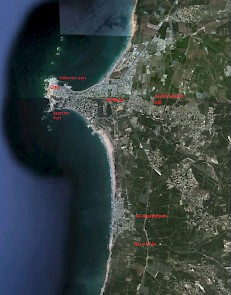
The Assyrians controled the entire Near East. In Tyre, the local king had been forced to accept a royal deputy; elsewhere, provincial governors were in charge. However, Assyria seems to have suffered from imperial overstretch. Egypt turned out to be hard to keep. King Aššurbanipal (r.668-631) did sack Thebes in Egypt, but eventually had to give up the country of the Nile. One of his local vassals, Psammetichus, hired Greek and Carian mercenaries, managed to reunite Egypt and regain its independence. At the same time, the Medes and Babylonians attacked Assyria. Minor political leaders like king Josiah of Judah (r.640-610) contributed to the decline by conquering parts of the Assyrian Empire, and it is likely that Tyre attempted the same. In 612, the Medes and Babylonians captured Nineveh.note
The new superpower was Babylonia, and although it would essentially continue the Assyrian Empire, there were changes. For example, its chroniclers were less interested in war than the authors of our Assyrian sources. Babylonian writeres were focused on the main sanctuary in the capital, the Esagila in Babylon. As a consequence, our sources are completely different in nature, and we learn less about the relations between the central government and the vassal kingdoms. For some forty years, from 630 to 590, the cuneiform sources are silent about Tyre.
However, from chronicles ABC 4 and ABC 5 is quite clear that the first aim of king Nebuchadnezzar (r.605-562) was to seize the former Assyrian provinces in the west, where the Egyptian pharaoh Necho II (r.610 to 595) had succeeded Josiah of Judah as the main aggressor. The Phoenician cities traditionally had good relations with Egypt, and it comes as no surprise that in these years, Necho employed Tyrian merchants to circumnavigate Africa. The reason for this enterprise may have been to open a sea road to attack Babylonia from the south. As it happened, Nebuchadnezzar rapidly pushed the Egyptians out of Asia, and Egypt lost its appetite for a continued war against Babylonia. The main benefactors of the circumnavigation of Africa may have been the Tyrians and Carthagians: Hanno founded Lixus and several other towns in what is now Morocco.
There is an interesting text, probably written in the 580s, that describes Tyre as a flourishing city. It's the "funeral song" by the prophet Ezekiel, who predicts the sack of the city and sums up all kind of special Tyrian products: blankets, cedar wood, coral, cypress wood, ebony, embroidery, emerald, figs, goats, gold, honey, iron, ivory, lambs, lead, linen, oak wood, olive oil, pine wood, purple, rope, rubies, rugs, sheep, silver, slaves spices, tin, wheat, wine, wool. Soldiers were hired in Persis, Lydia, Libya, Phoenicia, and Cilicia.
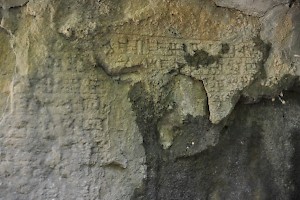
The fact that Egypt had retreated from Asia did not mean that it was no longer interested. Judah and Tyre were useful pawns in the game between the pharaoh and the king of Babylonia. If we are to believe Flavius Josephus, who quotes Menander of Ephesus, the siege of Tyre lasted thirteen years and started in Nebuchadnezzar's seventh regnal year (598/597; text).This is also the year in which the Babylonians captured Jerusalem for the first time and appointed Zedekiah as king in Judah (ABC 5). Jerusalem, which had been enticed to revolt by pharaoh Apries, was captured again in 587, and the inhabitants were deported. Tyre fell in Nebuchadnezzar's twentieth year (585/584).
The difference between Tyre and Jerusalem was that the Phoenician city had not been captured. We know that the king, Ba'al II, had to accept a permanent Babylonian official at court (an arrangement that Ba'al I had already agreed with). It seems that hostages were given: ANET3 308 mentions food supplies for 126 Tyrians who were held in Babylon. If we are to believe the words of Menander of Ephesus, there was a republican experiment after the death of Ba'al II. After six years, the monarchy was restored.
The main result of the protracted war against Babylonia and the political changes in Tyre was that the colonies in the western Mediterranean were lost. They started to accept Carthage as their leader. As a consequence, Tyre diminished in importance.
Persian Age
The Babylonian Empire was taken over by the Achaemenid Persians in 539, when Cyrus the Great captured Babylon. The evidence again changes its nature. Cuneiform writing was gradually replaced by the Aramaic script, and clay tablets were replaced by papyrus and parchment. This meant, on the one hand, that information spread easily; we can read about Tyre in sources from faraway countries like Greece. At the same time, it meant that information was more vulnerable. The papyri and parchments from Tyre itself, and from the cities directly surrounding it, are lost.
Nevertheless, it is clear that the Persians quickly took over the western provinces of the Babylonian Empire, and made Sidon the main center of their rule in Phoenicia. Tyre is mentioned occasionally: when the exiled Jews were allowed to return to Jerusalem, the Tyrians sold them cedar wood to rebuild the temple,note and there were Tyrian fish merchants living in Jerusalem.note There was some construction work at Tyre, like the so-called Tomb of Hiram.
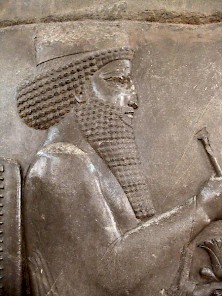
More important was the construction of a Persian navy, which Cyrus' son Cambyses used to attack Egypt (525). This had very serious implications. A navy usually is based in a limited number of ports, but these towns cannot maintain all the ships. There has to be a system that enables the ports to support a fleet that the coastal cities themselves cannot maintain. King Darius I the Great (r.522-486) decided to use a very recently discovered instrument to bring capital from all over the Empire to cities like Sidon and Tyre: coinage. A tribute system was introduced. Likewise, the Achaemenid navy in Phoenicia, which consisted of three hundred triremes, needed some 50,000 rowers, which was more than the Phoenician cities could maintain. The rowers must have been recruited all over the empire, making Phoenicia a very cosmopolitan country. (The model of cash payments and hired rowers, would later be copied by the Delian League of Athens.)
Our main source for the first half century of Persian rule is the Greek researcher Herodotus of Halicarnassus, who mentions that the Tyrians were loyal to the Great King, took part in the Egyptian expedition and created a "Tyrian Quarter" in Memphis.note but refused to serve in an expedition against their own colony, Carthage. On the other hand, the Phoenician navy took part in the suppression of the Ionian Revolt and the Greek expedition of Darius' son and successor Xerxes (r.486-465). The king of Tyre, Mattan IV, is mentioned as personally taking part in the war.note but it is clear that the Sidonian king was the most important one.
Phoenician naval forces fighting for Persia are also mentioned during the reigns of the kings Artaxerxes I Makrocheirnote and Darius II Nothus.note During the reign of Artaxerxes II Mnemon, however, the city was captured by the Cypriot king Euagoras of Salamis. He had been a loyal vassal of the Persian king, but had revolted, and had (being supported by Achoris of Egypt, Hecatomnus of Caria, and Athens) managed to seize control in Tyre, where a pro-Euagoras party must have existednote In 386-384, the Persians subdued him again and must have reoccupied Tyre.
At the end of the reign of Artaxerxes II, in 360, the Phoenician cities were the target of an expedition by pharaoh Teos, but an internal revolt in Egypt put an end to his ambitions. His successor Artaxerxes III Ochus inherited a Phoenicia that was sufficiently loyal to its Persian king to enable him to threaten to intervene in the Social War between Athens and it allies (357-355): he could rely on the fleets in Aradus, Sidon, and Tyre. When a couple of years later Sidon, enticed by pharaoh Nectanebo II, revolted, Tyre and the other Phoenicians remained loyal to Persia.
By now, Athens was a major player in the economy of the Eastern Mediterranean. Athenian coins were found everywhere and by the mid-fourth century, Tyre started to use weights, measures, and coins based on the Athenian standard. This spread of Greek culture ("Hellenism") is commonly associated with the conquests of Alexander the Great, but it had in fact started earlier.
Alexander
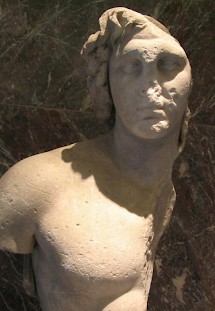
The war between Macedonia and the Persian Empire would, under normal circumstances, have taken place far from Tyre, but the Persians used their Phoenician navy to sail into Aegean Sea, and threatened Macedonia and Greece. Alexander commanded his armies to move to the east, where he defeated the Persian king Darius III Codomannus in the battle of Issus (November 333). Most Phoenician cities surrendered and the fleets they had sent out to the west, returned home after the winter.The only Phoenician city that refused to come to terms was Tyre, and Alexander knew that the siege was going to last for months.
Tyre had offered surrender, but had refused Alexander the right to sacrifice in the temple of Melqart during the great festival in February, because only the Tyrian king, Azemilk, could perform the necessary religious ceremonies. But he was still in the Aegean. Alexander had felt insulted and had insisted, and this was the sole cause of the siege. No Assyrian, Babylonian, or Persian king had ever made such an outrageous demand.
Another reason why Tyre resisted, was that Persian rule had been friendly. Its king had a Persian deputy and there may have been a garrison, which delimited the city's freedom, but it had also been allowed to keep its normal territory from Sarepta in the north to Acre in the south: it was one of the largest city states in the Mediterranean world, and after the suppression of the revolt in Tyre, it had become the leading city among the Phoenicians again. The Tyrians must have felt a genuine sympathy for the Persians.
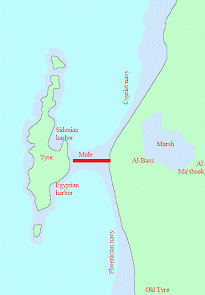
In January 332, the siege began. To reach the Tyrian walls, the Macedonians built a mole. But the Tyrians had more ships than the Macedonians, and made construction work extremely difficult. Half a year of hard labor and little progress passed. Alexander needed ships to protect the construction, and he was lucky, because in July, the Phoenician fleets returned home and sided with Macedonia. In July, the town was attacked from three sides: the Phoenician fleet destroyed the Tyrian fleet in the "Egyptian port"; Macedonian ships attacked the walls with siege engines; and marines from Cyprus landed in the "Sidonian port" and forced their way into the city.
According to our sources, 6,000 Tyrians were killed during the fighting in the streets. 4,000 Macedonians were wounded, perhaps 500 were killed. Alexander's indulged in his anger: he ordered 2,000 Tyrians to be crucified on the beach (text). After this, he repopulated Tyre with Greek emigrants and loyal Phoenicians, together with a permanent Macedonian garrison. This was the beginning of the Hellenistic age.